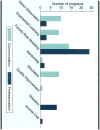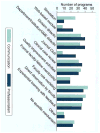Are pediatric critical care medicine fellowships teaching and evaluating communication and professionalism?
- PMID: 23867427
- PMCID: PMC4112058
- DOI: 10.1097/PCC.0b013e31828a746c
Are pediatric critical care medicine fellowships teaching and evaluating communication and professionalism?
Abstract
Objectives: To describe the teaching and evaluation modalities used by pediatric critical care medicine training programs in the areas of professionalism and communication.
Design: Cross-sectional national survey.
Setting: Pediatric critical care medicine fellowship programs.
Subjects: Pediatric critical care medicine program directors.
Interventions: None.
Measurements and main results: Survey response rate was 67% of program directors in the United States, representing educators for 73% of current pediatric critical care medicine fellows. Respondents had a median of 4 years experience, with a median of seven fellows and 12 teaching faculty in their program. Faculty role modeling or direct observation with feedback were the most common modalities used to teach communication. However, six of the eight (75%) required elements of communication evaluated were not specifically taught by all programs. Faculty role modeling was the most commonly used technique to teach professionalism in 44% of the content areas evaluated, and didactics was the technique used in 44% of other professionalism content areas. Thirteen of the 16 required elements of professionalism (81%) were not taught by all programs. Evaluations by members of the healthcare team were used for assessment for both competencies. The use of a specific teaching technique was not related to program size, program director experience, or training in medical education.
Conclusions: A wide range of techniques are currently used within pediatric critical care medicine to teach communication and professionalism, but there are a number of required elements that are not specifically taught by fellowship programs. These areas of deficiency represent opportunities for future investigation and improved education in the important competencies of communication and professionalism.
Figures
Comment in
-
Communication and professionalism: are we caught napping?Pediatr Crit Care Med. 2013 Jun;14(5):539-40. doi: 10.1097/PCC.0b013e31828a814d. Pediatr Crit Care Med. 2013. PMID: 23867431 No abstract available.
References
-
- Accreditation Council for Graduate Medical Education Program and Institutional Guidelines. [Accessed July 10, 2012]; Available online at: http://www.acgme.org/acgmeweb/tabid/83/ProgramandInstitutionalGuidelines....
-
- Carraccio C, Englander R. Innovation in pediatric education: the path to transforming pediatric graduate medical education. Pediatrics. 2010;125(4):617–618. - PubMed
-
- American Board of Pediatrics. The Pediatrics Milestones Project. [Accessed July 15, 2012]; Available online at: https://www.abp.org/abpwebsite/publicat/milestones.pdf.
-
- Calhoun AW, Rider EA, Meyer EC, et al. Assessment of communication skills and self-appraisal in the simulated environment: feasibility of multirater feedback with gap analysis. Simul Healthc. 2009;4(1):22–29. - PubMed
Publication types
MeSH terms
Grants and funding
LinkOut - more resources
Full Text Sources
Other Literature Sources
Medical



